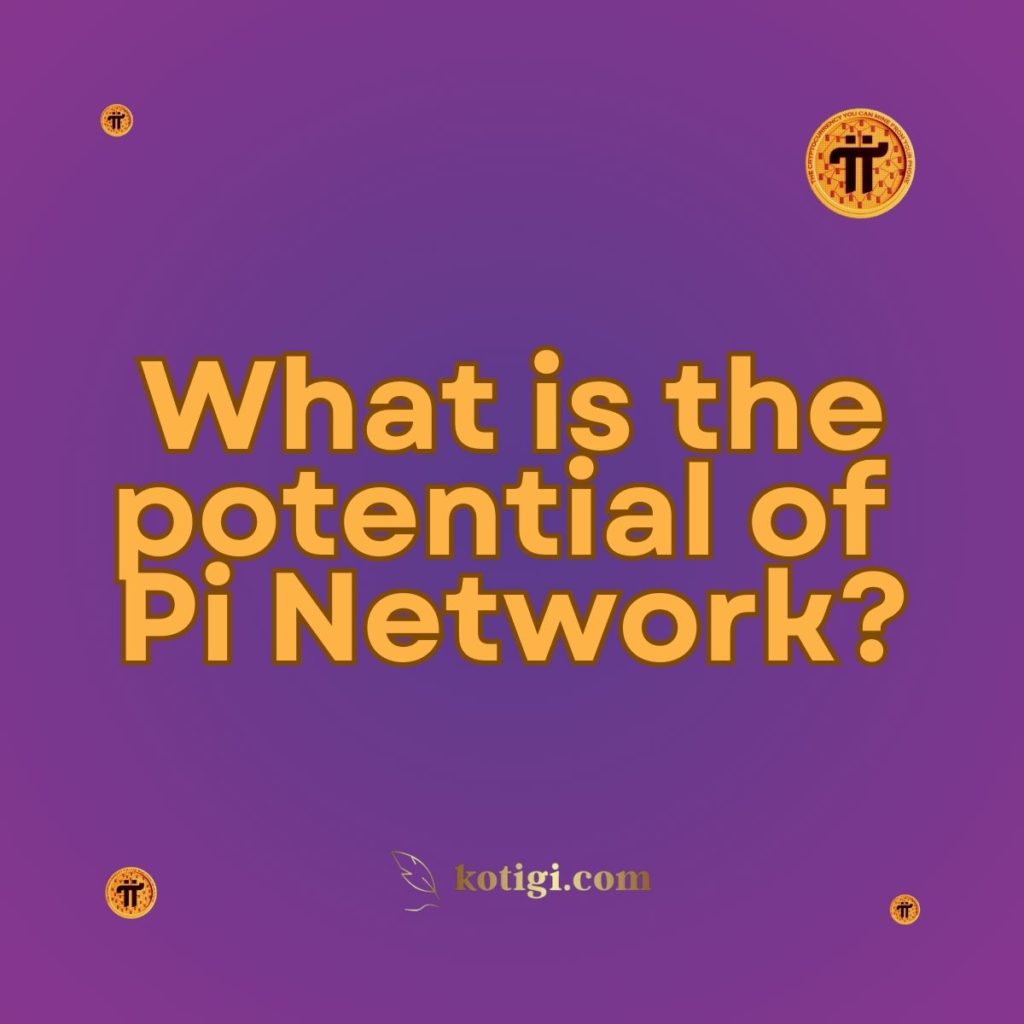
What is the potential of Pi Network?
Pi Network has the potential to revolutionize the cryptocurrency landscape through mobile mining, decentralization, and widespread accessibility. With millions of users already on board and a focus on real-world applications, Pi is set to establish a significant presence in the future of digital currencies.
Introduction
Cryptocurrencies have made a remarkable impact on the global economy, changing how we think about finance, investment, and the very concept of money. Among the new generation of cryptocurrencies, Pi Network stands out due to its novel approach, which emphasizes accessibility, community engagement, and the use of mobile mining technology. Unlike established players like Bitcoin and Ethereum, Pi Network is designed for everyone, even those without access to expensive hardware. But what is the true potential of Pi Network? Could it redefine the future of cryptocurrency? Let’s explore the various aspects of Pi Network that contribute to its potential.
1. A Unique Approach to Mining
One of Pi Network’s most distinguishing features is its innovative mining system. Unlike Bitcoin and many other cryptocurrencies that rely on energy-intensive proof-of-work algorithms, Pi Network has created a model that allows users to mine Pi directly from their mobile phones.
1.1 Energy Efficiency and Accessibility
Unlike traditional mining, Pi’s process does not require large amounts of electricity. This makes it more environmentally friendly and sustainable. Pi’s mobile-first approach has the potential to bring millions into the cryptocurrency space who otherwise would have been excluded by the barriers of traditional mining methods.
1.2 Democratization of Cryptocurrency
By removing the need for specialized hardware, Pi Network democratizes cryptocurrency mining. It gives individuals from all over the world, even those in regions with limited technological infrastructure, an opportunity to participate in blockchain technology and reap the benefits of cryptocurrency ownership.
1.3 Lowering the Barriers for Participation
Pi’s mining model also reduces entry barriers for people who are new to cryptocurrencies. The simplicity of mining Pi on a smartphone app makes it easy for users of all skill levels to get involved without the technical complexities of traditional mining.
2. A Strong Focus on Community
Pi Network is built with the community at its core. The developers of Pi believe that the success of any decentralized system depends on the strength of its user base, and Pi is no exception.
2.1 Community-Based Security Model
Pi’s security is maintained by its users through a system of “security circles.” Rather than relying on costly miners and nodes to verify transactions, Pi entrusts its users to secure the network by building circles of trusted individuals. This not only reinforces the network’s security but also fosters trust and a sense of ownership among users.
2.2 Empowering Users as Stakeholders
In Pi’s ecosystem, users are not just passive participants. By contributing to the security of the network and being actively involved in its governance, Pi users are empowered to shape the platform’s future. This strengthens Pi’s community and sets it apart from other cryptocurrencies that do not prioritize user engagement to the same degree.
2.3 Viral Growth Through Word of Mouth
The rapid growth of Pi Network has been fueled by its referral system, which rewards users for bringing others into the network. This method of growth has led to Pi reaching millions of users in a relatively short period, far exceeding the growth of many other blockchain projects during their early stages.
3. Scalability and Infrastructure
As Pi Network continues to expand, scalability will be one of the key factors determining its long-term success. Pi’s infrastructure is designed with scalability in mind, aiming to support millions, if not billions, of transactions in the future.
3.1 Scalability Without Compromising Speed
Pi’s consensus algorithm is designed to ensure that the network remains scalable while maintaining fast transaction speeds. As more users join the network and the volume of transactions increases, Pi’s infrastructure should be able to handle this growth without experiencing the congestion and high fees that have plagued other networks like Ethereum.
3.2 Pi’s Layered Approach to Blockchain
Pi Network plans to implement a layered blockchain architecture, allowing it to accommodate various types of transactions and applications while keeping the main blockchain efficient. This flexibility will enable Pi to support both microtransactions and larger, more complex operations, catering to a broad range of use cases.
3.3 Smart Contracts and Decentralized Applications (DApps)
Pi’s blockchain will support smart contracts and decentralized applications (DApps), which will enable developers to build on the platform and create new use cases for Pi. The introduction of smart contracts will significantly increase Pi’s functionality and enhance its potential to become a leading blockchain ecosystem.
4. Real-World Use Cases
For Pi Network to achieve widespread adoption, it must demonstrate real-world applications. The success of any cryptocurrency depends not only on its technological merits but also on its ability to solve real-world problems.
4.1 Building a Decentralized Marketplace
One of the primary goals of Pi Network is to build a decentralized marketplace where users can buy and sell goods and services using Pi. This marketplace would give Pi real-world utility, allowing it to function as a medium of exchange.
4.2 Merchant Integration and Adoption
Another potential use case for Pi lies in merchant adoption. If Pi can secure partnerships with merchants and service providers who accept Pi as payment, it could gain legitimacy as a widely used currency. Merchant adoption is often a critical factor in determining the success and longevity of a cryptocurrency.
4.3 Pi as a Means of Payment
Pi’s ease of use and low transaction costs could make it an attractive option for users seeking to make international payments or small transactions. The ability to send payments quickly and cheaply across borders is one of the key features that could make Pi a popular choice for everyday transactions.
5. Security and Trustworthiness
As with any blockchain, security is a paramount concern. Pi Network has developed a security model that is decentralized, relying on its users to maintain the integrity of the network.
5.1 Decentralized Validation through Security Circles
Rather than relying on centralized nodes or large-scale miners, Pi Network employs a decentralized security model where users validate transactions through security circles. This structure makes the network less susceptible to centralized attacks and enhances its overall security.
5.2 Strong Community Oversight
The community-driven nature of Pi Network means that any malicious activity is likely to be quickly identified and mitigated by users. This distributed model of oversight ensures that the network remains resilient in the face of potential threats.
5.3 Privacy Considerations
Pi Network has also incorporated strong privacy protections into its platform. While users’ identities must be verified through the KYC process, the platform ensures that personal data is protected and not misused, providing an additional layer of trust for participants.
6. Regulatory Compliance and Global Adaptability
One of the biggest challenges for Pi Network will be navigating the evolving regulatory landscape. Cryptocurrencies have often faced legal challenges as governments attempt to regulate digital assets, and Pi will need to ensure that it complies with relevant laws and regulations.
6.1 KYC Requirements
Pi Network has already implemented Know Your Customer (KYC) procedures to verify user identities, which is essential for regulatory compliance. By adhering to KYC and anti-money laundering (AML) regulations, Pi Network positions itself as a legitimate project capable of navigating legal scrutiny.
6.2 Adaptation to Local Regulations
Pi Network must also be adaptable to the specific regulatory requirements of different countries. As governments continue to refine their approach to cryptocurrency regulation, Pi’s ability to comply with diverse legal frameworks will be essential for its global expansion.
6.3 Future-Proofing Against Legal Changes
In a rapidly changing regulatory environment, Pi Network must remain flexible. By building a robust legal framework from the beginning, Pi will be better equipped to handle future regulatory changes, ensuring its long-term viability.
Conclusion
Pi Network has the potential to become a major force in the cryptocurrency world. With its innovative mobile mining technology, strong community engagement, real-world use cases, and commitment to scalability, Pi is well-positioned for future growth. However, its ability to navigate regulatory challenges and deliver on its promises will determine whether Pi can achieve widespread adoption and become a legitimate contender in the world of digital currencies. The project’s unique approach to decentralization, combined with its focus on user accessibility, gives it a strong foundation to build upon in the coming years.
Key Takeaways
- Mobile Mining: Pi Network’s mobile mining model lowers barriers, allowing anyone with a smartphone to mine cryptocurrency.
- Community-Driven Growth: Pi Network relies on its users to secure the network and foster growth through a referral system.
- Scalability: Pi is designed to scale effectively, with the infrastructure in place to handle a growing user base and transaction volume.
- Real-World Applications: Pi aims to create a decentralized marketplace and drive merchant adoption to give its cryptocurrency tangible value.
- Security: Pi Network uses decentralized security circles to ensure that the network remains secure and resilient.
- Regulatory Compliance: By implementing KYC and adhering to AML regulations, Pi Network positions itself for global legal compliance.
- Future Vision: Pi’s long-term vision includes supporting smart contracts, DApps, and global merchant adoption, giving it significant potential in the digital economy.





